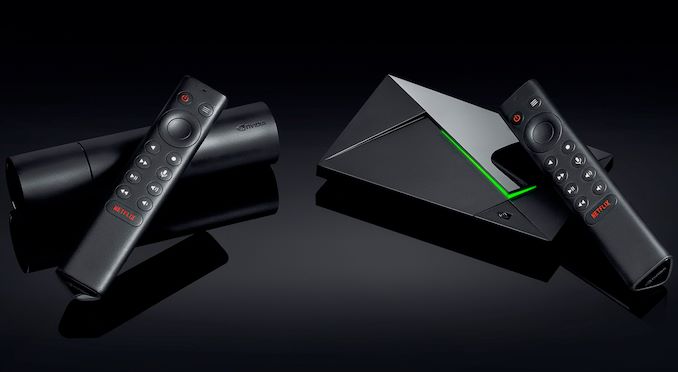
NVIDIA has introduced new versions of its SHIELD TV set-top-boxes featuring an all-new design as well as based on an improved Tegra X1+ SoC. The new STBs support all the features its predecessors do and add support for Dolby Vision HDR, Dolby Atmos audio, as well as a new AI-powered upscale algorithm. With the launch of the new devices NVIDIA somewhat changes concept of its STBs as they no longer come with a gamepad.
The new NVIDIA SHIELD TV devices use the company’s new Tegra X1+ SoC that is said to be 25% faster when compared to the original one launched over four years ago. The chip essentially has the same feature set and Maxwell graphics, so games developed with the original SoC in mind will work with the new one without any problems. Meanwhile, since the Tegra X1+ is made using a more advanced process technology, this allows NVIDIA to offer the new SHIELD TV in a more compact form-factor. At the same time, the new SoC is paired with 2 GB of RAM (down from 3 GB) as well as 8 GB of NAND flash storage (down from 16 GB previously), which can be expanded using a microSD card. The SHIELD Pro has 3 GB of RAM as well as 16 GB of NAND storage, but no longer has a hard drive.
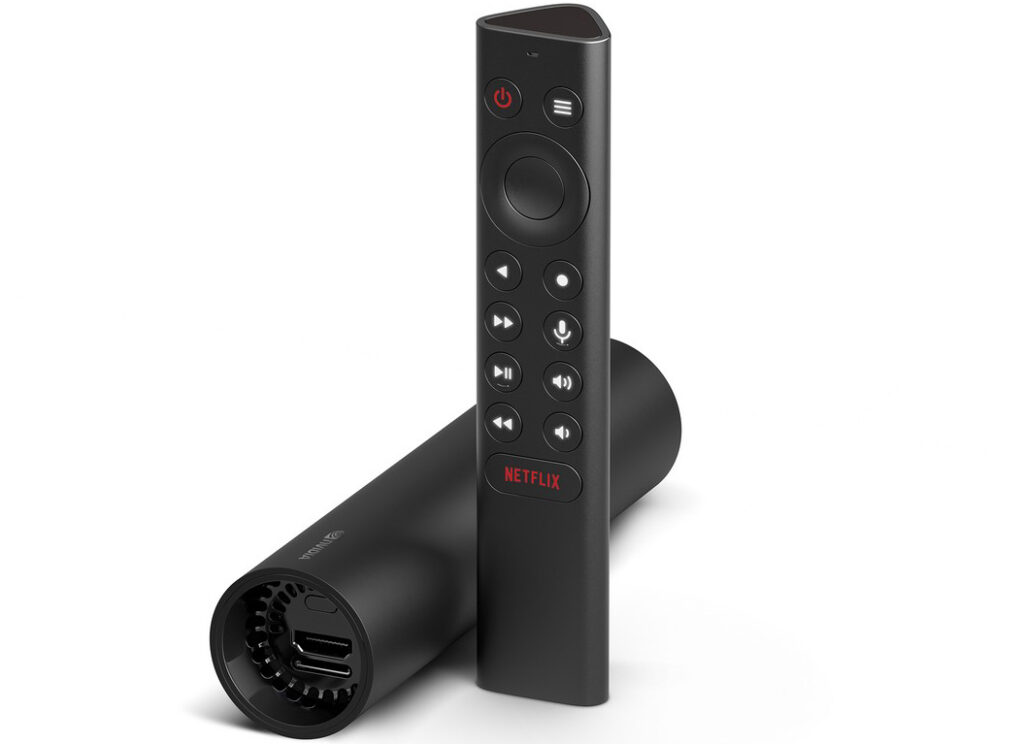
NVIDIA made its new SHIELD TV smaller than the predecessor in a bid to better compete against compact streaming media device, such as Google’s Chromecast/Chromecast Ultra. From connectivity standpoint, the new STB features Wi-Fi 5, Bluetooth 5.0, a GbE port, an HDMI 2.0b output with HDCP 2.2, and a microSD card slot. Meanwhile, it no longer has USB 3.0 ports, possibly to save space and simplify design. Those who need USB 3.0 should buy the SHIELD Pro with two USB Type-A ports.
| SHIELD TV (2019) | SHIELD TV Pro (2019) | SHIELD TV (2017) | SHIELD TV Pro (2017) | SHIELD Android TV (2015) | ||
| SoC | Tegra X1+ | Tegra X1 (4 × Cortex A57 + 4 × Cortex A53, Maxwell 2 SMM GPU) | ||||
| RAM | 2 GB | 3 GB | 3 GB LPDDR4-3200 | |||
| Storage | 8 GB NAND microSD | 16 GB NAND USB | 16 GB NAND USB | 16 GB NAND 500 GB HDD microSD USB | 16 GB NAND 500 GB HDD (Pro only) microSD USB | |
| Display Connectivity | HDMI 2.0b with HDCP 2.2 (4Kp60, HDR) | |||||
| Dimensions | Height | 40 mm 1.57 inch | 98 mm 3.858 inch | 130 mm 5.1 inch | ||
| Width | 40mm 1.57 inch | 159 mm 6.26 inch | 210 mm 8.3 inch | |||
| Depth | 165 mm 6.5 inch | 26 mm 1.02 inch | 25 mm 1 inch | |||
| Weight | 137 grams | 250 grams | 654 grams | |||
| Power Adapter | integrated | ? | 40 W | |||
| I/O | Wireless | 2×2 802.11a/b/g/n/ac Bluetooth 4.1/BLE | ||||
| USB | – | 2 × USB 3.0 | 2 × USB 3.0 1 × micro-USB 2.0 | |||
| IR | – | – | – | IR Receiver | ||
| Ethernet | Gigabit Ethernet | |||||
| Launch Product Bundle | Shield Remote | Shield Controller Shield Remote | Shield Controller | |||
| Launch Price | $149.99 | $199.99 | $199.99 | $299.99 | Basic: $199.99 | |
When it comes to decoding capabilities, the new SHIELD TV can decode H.265/HEVC, VP8, VP9, H.264, MPEG1/2, H.263, MJPEG, MPEG4, and WMV9/VC1 video. Meanwhile, the STB does not support AV1 as well as VP9.2 codecs because they are not widespread at the moment. The new SHIELD TV can playback 4Kp60 HDR, 4Kp60, Full-HD 60 fps content, and can upscale 720p and 1080p content to 4Kp30 using an AI-enhanced algorithm. It is unclear whether the algorithm relies on a new hardware block that is present only inside NVIDIA’s Tegra X1+, or uses a combination of hardware and software, which means that it could be enabled on previous-generation SHIELD TV consoles too
| NVIDIA’s 2019 SHIELD TV STBs | |||
| Video | |||
| 4K HDR at 60 FPS | H.265/HEVC | ||
| 4K at 60 FPS | VP8, VP9, H.264, MPEG1/2 | ||
| 1080p at 60 FPS | H.263, MJPEG, MPEG4, WMV9/VC1 | ||
| HDR | HDR10, Dolby Vision | ||
| Containers | Xvid/ DivX/ASF/AVI/MKV/MOV/M2TS/MPEG-TS/MP4/WEB-M | ||
| Audio | |||
| Audio Support | AAC, AAC+, eAAC+, MP3, WAVE, AMR, OGG Vorbis, FLAC, PCM, WMA, WMA-Pro, WMA-Lossless, Dolby Digital Plus, Dolby Atmos, Dolby TrueHD (pass-through), DTS-X (pass-through), and DTS-HD (pass-through) | ||
| High-Resolution Audio Playback | up to 24-bit/192 kHz over HDMI and USB | ||
| High-Resolution Audio Upsample | up to 24-bit/192 kHz over USB | ||
The new SHIELD TV STBs come with a redesigned SHIELD remote with improved ergonomics and more buttons. The unit has a built-in microphone for Google Assistant and Amazon Alexa; motion-activated backlit buttons; Bluetooth connectivity to connect to the player; and an IR blaster to control volume and power on TVs, soundbars or receivers.
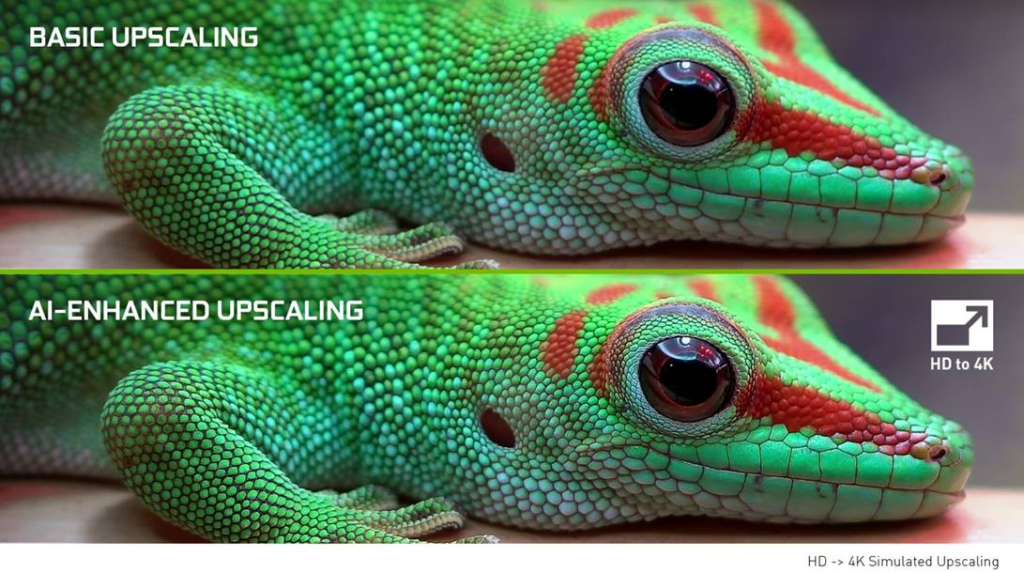
Being based on Android TV/Android 9.0 (Pie) platform, the SHIELD TV ships with a variety of content deliver apps, including Netflix, YouTube, Amazon Prime Video, Amazon Music, Vudu, Google Play Movies & TV, Plex, Google Play Games, NVIDIA Games, and Google Games. End-users may install additional apps themselves if they need to.
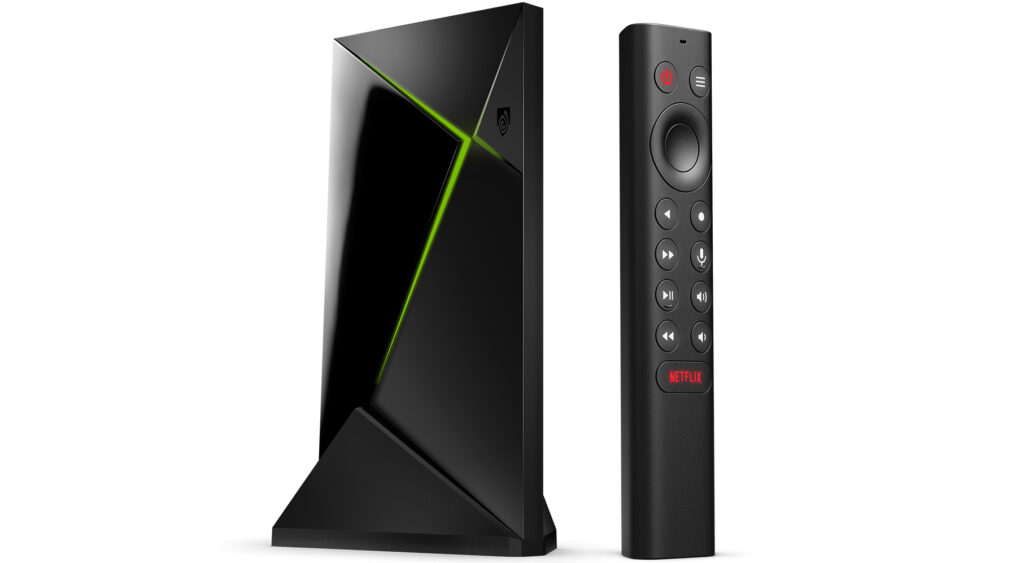
Because of the simplified design and the lack of bundled gamepad, the new NVIDIA SHIELD TV media players are cheaper than their predecessors: the base model costs $149.99 (down from $199.99), whereas the Pro model is priced at $199.99 (down from $299.00).
Audio Formats
As you’d expect, every NVIDIA Shield is compatible with a range of audio codecs, including:
- AAC
- AAC+
- eAAC+
- MP3
- WAVE
- AMR
- OGG Vorbis
- FLAC
- PCM
- WMA
- WMA-Pro
- WMA-Lossless
- Dolby Atmos
- Dolby TrueHD
- DTS-X
- DTS-HD
The Dolby and DTS codecs all support pass-through. That means you can output audio content to a soundbar or audio receiver through your TV even when the receiver is in standby mode.
There’s something for Audiophiles in the 2019 Shield TV too.
Compatible apps like Netflix, Prime. Disney+ and Vudu are now able to use Atmos sound, thanks to the Dolby audio license.
That also allows apps to downmix audio to Dolby Digital 5.1, which is great for older TVs and audio devices.
Connectivity Has Never Changed……
Every NVIDIA Shield include full gigabit Ethernet, as well as both 2.4GHz and 5GHz band Wi-Fi.
All Shields are also Bluetooth-enabled, but only the NVIDIA Shield 2019 has Bluetooth 5.0. Older versions use the older, slower Bluetooth 4.1.
All NVIDIA Shields come equipped with HDMI 2.0b, which has frustrated some consumers. Many expected the 2019 Shield to upgrade to the HDMI 2.1 spec. That almost doubles HDMI 2.0’s 18 Gbps bandwidth up to 30 Gbps.
It may not matter yet, but at 8k TVs starting to become more common, NVIDIA may be pressured to upgrade in the near future.
Some users, myself included, were frustrated by NVIDIA’s decision to drop the IR receiver with the NVIDIA Shield 2017 model. We’ll get into more detail about that when we talk about the remote controls in the next section.
NVIDIA Shield Remotes: 2015 vs. 2017 vs. 2019
You might be surprised, but some of the most controversial changes to the NVIDIA Shield over the years have been the remote controls!
No matter which version of the Shield TV you have, all of them can use the excellent official NVIDIA Shield app instead of the physical remote control.
Here’s another area where Shield TV owners have strong opinions, and I am definitely one of them.
At first glance, the 2015 and 2017 Shield remotes may look the same, but there are some major changes.
Both remotes have identical button layouts, with their voice command buttons, volume touch controls, back, and selection buttons.
They’re both small, sleek and feel amazing to hold in your hand. The differences stop there, however.
The 2015 Shield TV remote (below left) is made from metal, while the 2017 version is plastic.
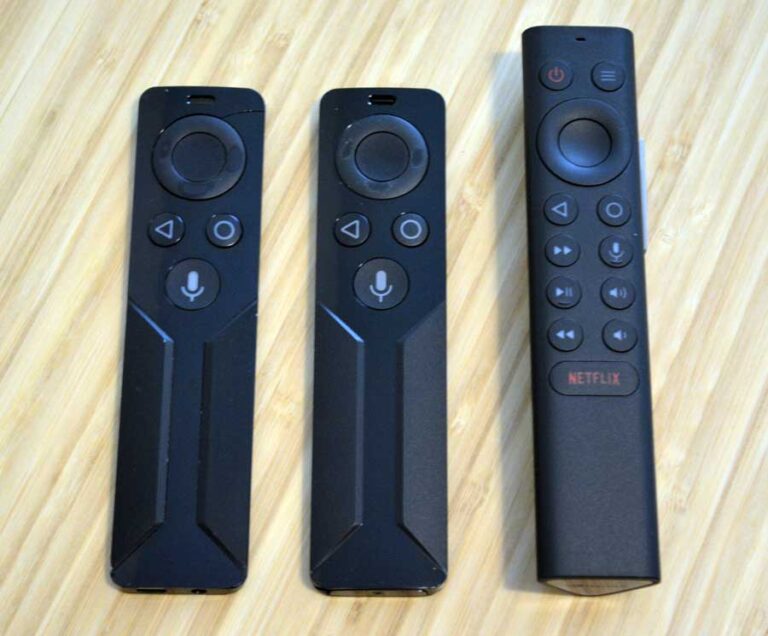
The original remote has a backlit voice button for Google Assistant and a headphone jack on the bottom. Both are missing from the 2017 Shield TV remote.
More importantly, the newer remote ditched the internal rechargeable battery for replaceable CR2032 batteries. Although I love the idea of rechargeable batteries, the battery life degraded quickly over time, so I’m a fan of this move.
The IR blaster on the 2017 remote allows users to power on/off or adjust the volume of other devices, as well as their Shield TV.
The NVIDIA Shield 2019 remote is the most…unique of the three.
Gone is the sleek design of the 2015 and 2017 Shield TV’s.
Instead, we get the triangle remote.
To be fair, the 2019 Shield remote has more buttons, including a dedicated Netflix button, and now features motion-sensing backlighting. You’ll also notice a new menu button and media controls (forward, back, and play/pause).
NVIDIA also replaced the volume slider with actual buttons. The slider was a cool idea, but a bit awkward to use.
Like the 2017 remote, this one is battery-powered. Only this time, you’ll need larger (and heavier) AAA batteries.
The newest Shield remote is backward compatible, so you can use it with either your NVIDIA Shield 2015 or 2017 Shield, if you want to.
Personally, I’m not a fan of the new remote and wish there was still a way to purchase one of the older remotes. Since I can’t buy the older versions, I started looking for some great replacement remotes that would would work with the Shield TV instead.
Android TV on NVIDIA Shield
Did you know that the NVIDIA Shield TV is one of the longest officially supported Android devices ever?
It’s true. My NVIDIA Shield 2015 gets the very same updates that my Shield 2019 does.
That’s huge.
Most Android users are lucky to get two years worth of updates, but NVIDIA promises the same Android TV experience on every Shield TV.
And thanks to the impressive hardware, the Shield TV is still outperforming and other Android TV device on the market.

All Shield TV’s support Chromecast 4K and Google Home, as you’d expect. However, Amazon Alexa did get limited support in a recent update.
The original NVIDIA Shield 2015 shipped with Android TV 5, and NVIDIA Shield 2017 models shipped with Android TV 7. Both Shields have since been upgraded to Android TV 9.
Android TV has hundreds of streaming and game apps available on each system. Exclusive to NVIDIA, you can also play games over the cloud via GeForce NOW, for an extra fee, or locally using NVIDIA GameStream.
Starting in 2017, Shields began listing local and remote games together, perhaps to highlight the GeForce Now subscription.
HDR10+
Finally, the NVIDIA Shield 2019 devices include support for Dolby Vision. Unfortunately, still no support for HDR10+ yet.
Dolby Vision is a premium HDR standard that builds on the foundations of HDR (high dynamic range) to give you better picture quality.
Previous versions of the NVIDIA Shield were compatible with the older HDR10 standard, which included static metadata with encoded color calibration settings to help make the picture look real. Dolby Vision allows for frame-by-frame color and brightness adjustments so each scene in the movie looks its best.
NVIDIA Shield CPU: Tegra X1 vs. X1+
In 2015, NVIDIA launched the Tegra X1 chip, and it’s still one of the most powerful chipsets in a streaming device today.
Then, in 2019, they offered an upgrade to NVIDIA’s Tegra X1+: a smaller chip with a faster GPU clock rate as well as lower heat output and power consumption.
To be honest, I don’t see a noticeable speed difference between the 1,267 MHz clock speed of the Tegra X1+ chip compared to the TegraX1’s 1,000 MHz clock speed.
If you have an NVIDIA Shield 2017 and are happy with it, this new chip may not be enough to upgrade.
NVIDIA Shield Storage & Memory
The biggest difference between the 2015 NVIDIA Shield vs the 2017 Shield TV and the 2019 Shield TV is their storage capacity. Each has a basic and Pro model.
The Shield TV Pro cost more, but sported a larger hard drive. However, the size varies depending on the model year.
For example, the 2015 Shield Pro came with a whopping 500GB hybrid hard drive that dwarfed the 16GB solid-state drive of the basic Shield TV. That meant plenty of room to store movies, TV shows, music, or games.
The NVIDIA Shield 2017 had similar offerings.
However, to keep costs down, NVIDIA reduced the size of the 2019 Shield Pro’s storage to just 16GB, and cut the Shield TV’s storage down to 8 GB.